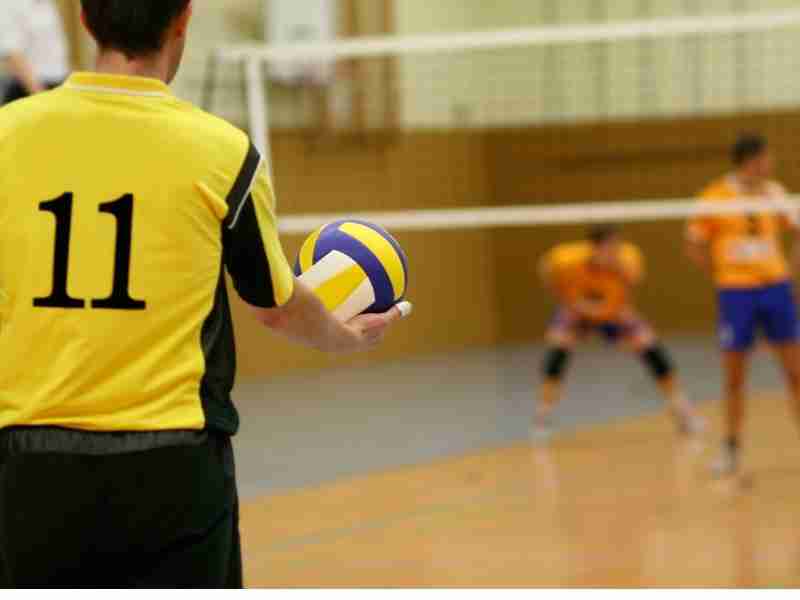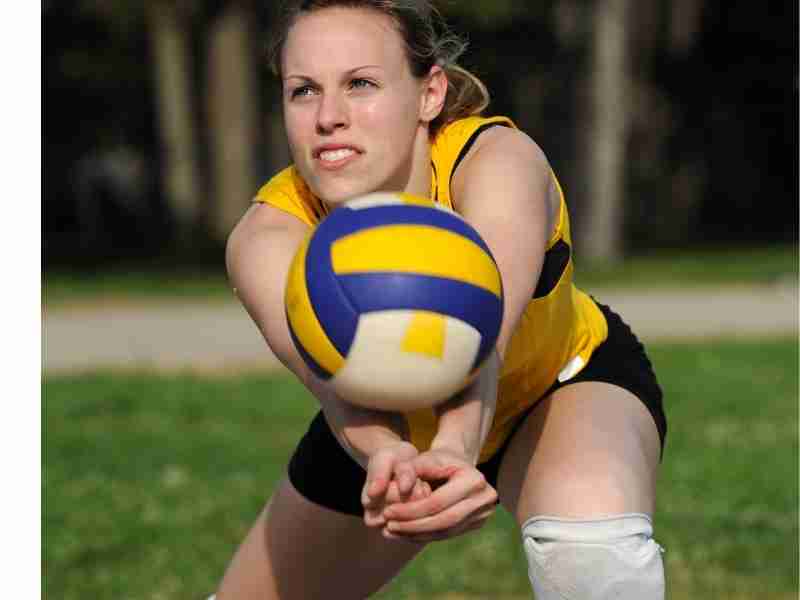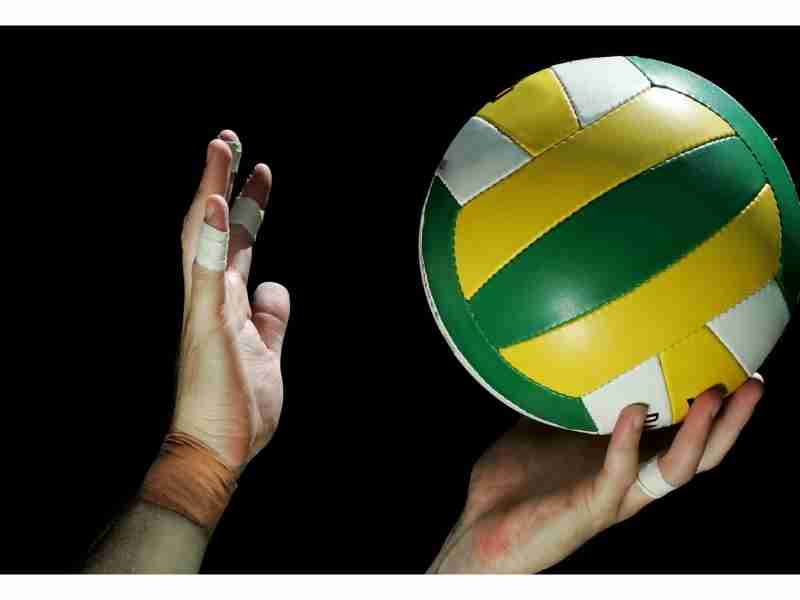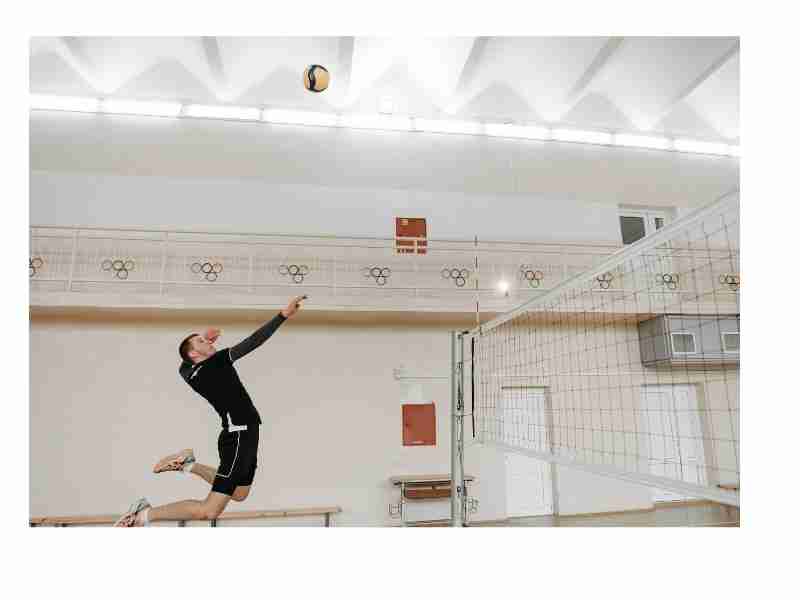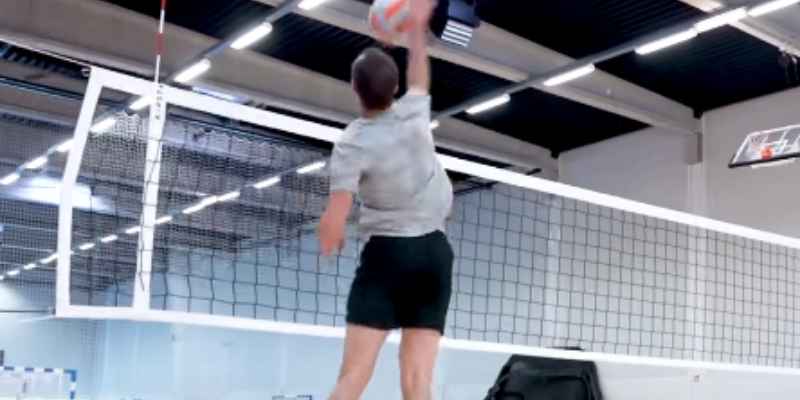
Do you know how to hit a volleyball with a spike? If not, don’t worry – you’re about to learn! The steps for spiking a volleyball are simple. In this blog post, we’ll teach you everything you need to know to Spike a volleyball like a pro.
A Volleyball Spike
Spiking a volleyball is one of the most exciting parts of the game. When done correctly, it can be a devastating weapon against your opponents. It would be best to approach the net with speed and power to spike the ball.
As you reach the net, extend your arm and snap your wrist to hit the ball with the palm of your hand. The speed and angle of your approach will determine how hard you hit the ball.
If you want to make a powerful spike, aim for the spot just behind the setter. This will allow you to put all of your weight behind the Spike. Remember to follow through with your arm after making contact with the ball. With practice, spiking can be an easy and effective way to win points.
Where Do You Begin On The Volleyball Court?
Every volleyball player has to find their starting point on the court. This spot should be comfortable for you and give you a clear view of the court so you can plan your approach. This starting point will depend on how long your typical approaches are and what position you play.
If you are a setter, you want to be closer to the net to see the whole court and your options. If you are a hitter, you will want to be further back to get a running start.
Ultimately, it is up to you to find the starting point that works best for you.
Outside Hitter
Outside Hitters are one of the most critical positions on a volleyball court. They are responsible for hitting the ball over the net and into the other team’s court.
Outside Hitters typically start their approach on the left side of the court, behind the 10-foot line. This enables them to hit the ball down the line or at an angle by turning their shoulders. They take their first step to the left to create a rounded “out-to-in” path that ends just inside the volleyball antenna.
Outside Hitters must have a strong arm and good hand-eye coordination to succeed in this position.
Outside Hitters play a vital role in any volleyball team and can often be the difference between winning and losing.
Middle Hitter
Middle hitters typically line up near the net in the center of the court. Their primary duty is blocking opposing players and hitting balls across the net.
Middle batters must also be able to hit the ball hard when it crosses the net. This necessitates good arm strength and accuracy.
Middle hitters typically begin their swing behind the 10-foot line, to the left of the setter. They can best predict where the ball will come from and where to place their hit from this position.
While middle hitters are essential in any volleyball game, they must be well-rounded players to succeed. They must be strong, agile, and have good hand-eye coordination.
Opposite Hitter
The best way to approach an opposite hitter is to begin your steps behind the 10-foot line that runs to the right side of the volleyball court. By taking your first step directly towards the net, you create a straight line that will end just inside the antenna. This gives you the best chance of contacting the ball in front of you and keeping it within your hitting zone.
Additionally, keeping your shoulders square to the net and your arms extended throughout the approach is essential. This will help you generate power and maintain control of the ball. With a bit of practice, you’ll be able to execute a perfect opposite hit every time.
Pin Hitters
The ball will determine where you are running when you start your approach. You should track the pass and begin to approach just before the setter. If the ball goes off the net, you can make last-second adjustments. You do not need to adjust your approach if the ball is headed towards the setter.
You can begin your approach when the ball is about halfway to the setter. This will allow you to stay in a good position to hit without making any last-second adjustments. When running a four or five set, it is vital to make these adjustments because they can make the difference between getting a kill and getting stuffed at the net.
Practice your approach and pin-hitting so that you can be prepared for anything that comes your way during a match.
Volleyball Spike Approach
Two main types of approaches are used in volleyball – the power approach and the float approach. The power approach is used when hitting the ball hard, while the float approach is used for placing the ball. When attacking, players will take a few steps back to get a running start before hitting the ball.
The best way to hit the ball hard is to use a powerful approach, which starts from behind the player’s body and ends in front. The player jumps and hits the ball with an extended arm, using their whole body to generate power. This approach is often used for spikes, allowing the player to hit the ball with more force.
However, this method can be more challenging to control where the ball goes. As a result, many players will use a float approach when they want to place the ball more accurately. This approach starts in front of the player’s body and ends behind it, resulting in a softer hit. While it doesn’t generate as much power, it gives the player more control over where the ball goes.
Moreover, when it comes to volleyball approaches, there are two main schools of thought: the three-step approach and the four-step approach. The three-step approach is typically used in faster attacks, such as a one-ball for the middle hitter or a shoot for the outside hitter.
The four-step approach is essentially the same as the three-step approach, with the addition of a short step at the start that serves as a guide.
Whichever approach you choose, practice it often so you can execute it flawlessly come game time.
4th Step Approach
Volleyball is a sport that requires split-second decisions and explosive movements. Players need to react quickly when spiking the ball and generate a lot of power.
The 4 step approach is a great way to increase your speed and power when spiking. It begins with a small step with your right foot, followed by a more extensive and faster step with your arms slightly ahead of your body. The third step is the most powerful and large, and your arms should swing back behind you.
The last step is quick as your arms explode forward, propelling you off the ground. This approach will help you generate more power and speed, giving you the edge you need to succeed on the court.
3r Step Approach
Players often wonder what the best approach is for spiking the ball. The 3 step approach is often the most effective. Here’s how it works:
First, take a short step with your left foot. Second, take a long and explosive step with your right foot. Finally, take your third and last step with your left foot, planting it firmly on the ground and bringing your arms behind you.
It also helps to keep you balanced so that you can stay on your feet when jumping up to hit the ball. Give it a try next time you’re in a game and see how well it works!
Making Contact
Regarding volleyball spikes, the key is to contact the ball in front of your head and to the right of your ear. This will help you generate more power and keep the ball from going into the net.
You must ensure your arm is fully extended when you hit the ball. This will help you get more power behind your Spike and increase your chances of landing it in bounds. By following these simple tips, you can make a volleyball spike that’s both powerful and accurate.
Read more About Basics of the Volleyball SpikeMid-air Volleyball Spike Tips
Mid-air volleyball spikes are one of the most impressive sports shots. Not only do they require a great deal of athleticism, but they also require split-second timing and precision. If you’re looking to add a Mid-air volleyball spike to your repertoire, there are a few things you need to keep in mind.
First, once you’re in the air, use your guide hand to help you get as high as possible. This will allow you to create more torque on your follow-through and generate more power.
Second, pull your swinging hand back in a “bow and arrow” motion. This will help you generate the necessary speed and spin to execute the perfect Mid-air volleyball spike.
Finally, constrict your core and swing your arm forward once the ball is in position. This will help ensure that you make contact with the ball in the sweet spot, resulting in a powerful attack.
If you keep these tips in mind, you’ll be well on your way to becoming a Mid-Air volleyball spike master.
Complete The Attack
Snapping your wrist down to impart a forward spin on the ball is one of the most crucial components of an attack in volleyball. This is something that novice players frequently overlook, resulting in spikes that fly out of play. Before moving on to timing with your setter, it’s crucial to make the entire hitting motion second nature and to practice your approach.
The most common type of injury is ankle sprains, which can occur when the foot lands awkwardly or is twisted in the wrong direction. Wearing Mizuno ankle braces can help reduce the risk of injury by providing support and stability to the ankle.
In addition, it is crucial to learn to control your body as best as possible when playing volleyball. This means using proper technique and avoiding dangerous moves that could put you at risk for injury.
Tips
Spiking the ball correctly can be tricky, but anyone can master the basics with practice.
One way to improve your spiking is to practice standing 10 feet away from a wall and spiking the ball so that it bounces off the wall and back to the floor, allowing you to spike it more. By completing this exercise, you will gain the timing and precision needed to carry out a successful spike.
In addition, it is essential to remember that a volleyball Spike is not just about hitting the ball hard. There are several other factors to consider, such as trajectory and angle.
By practicing with wall spikes, you can learn how to control the ball and ensure it goes where you want it to go. Volleyball is a game of precision, power, and coordination.
When you spike the ball, you have to put all your energy into making contact with it so that it goes over the net and lands in your opponent’s court.
However, if you reach over the net to Spike the ball, you are violating one of the game’s basic rules. Not only will this result in a point for your opponent, but you may also be given a warning. To avoid this, keep your feet on your side of the net and focus on making a clean strike.
What Are The Step Approaches In Spiking In Volleyball?
Several approaches to spiking in volleyball depend on the situation and the player’s strengths. The most common approach is the arm swing, often used when the player is close to the net and has a good amount of power.
Another common approach is the hip lift, which is used when players want more control over their Spike or when they are farther from the net. There are also approaches such as the jump float and standing float, often used when receiving a serve or setting up a play.
In other words, when spiking in volleyball, you want to approach the ball as close to the net. This will give you the best chance of hitting it hard and scoring a point. There are three basic steps that you can take when approaching the ball:
1. Approach from the front court – this is the best option if you have enough time to get to the ball.
2. Approach from the backcourt – this is a good option if you need to cover more ground quickly.
3. Jump approach – this is only for players who are very good at spiking and have plenty of time to jump and hit the ball.
How To Spike The Ball From The Outside Hitter Position On The Volleyball Court?
When spiking from the outside hitter position, you’ll want to aim for the most left-facing part of the net. This will give you the best chance of hitting the ball into the opposing court. Make sure you jump high and extend your arm to make contact with the ball.
To get into position, start by positioning yourself at the left side of the court, with your feet parallel to the sideline, as you can see the court so you can block.
Next, jump up and pivot so that your right foot is in front of your left foot (the opposite of how you’d pivot if you were serving). Then, swing your arms and hit the ball towards the left side of the net.
Keep your body facing forward to maintain momentum through contact with the ball.
Bottom Line
We have looked at the basic steps involved in spiking a volleyball and where to start on the court. It is important to remember that these steps are just guidelines; you may find that you need to adjust them depending on the situation. Stay calm and focused, and be sure to practice regularly so that you can spike the ball with power and accuracy.



